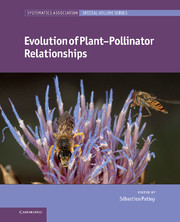Book contents
- Frontmatter
- Contents
- Contributors
- Preface
- 1 Macroevolution for plant reproductive biologists
- 2 Pollination crisis, plant sex systems, and predicting evolutionary trends in attractiveness
- 3 Evolution and ecological implications of “specialized” pollinator rewards
- 4 Fig–fig wasp mutualism: the fall of the strict cospeciation paradigm?
- 5 Fossil bees and their plant associates
- 6 Pollen evidence for the pollination biology of early flowering plants
- 7 Pollinator mediated floral divergence in the absence of pollinator shifts
- 8 Animal pollination and speciation in plants: general mechanisms and examples from the orchids
- 9 Why are floral signals complex? An outline of functional hypotheses
- 10 A survey on pollination modes in cacti and a potential key innovation
- 11 Zygomorphy, area, and the latitudinal biodiversity gradient in angiosperms
- 12 Ambophily and “super generalism” in Ceratonia siliqua (Fabaceae) pollination
- 13 Structure and dynamics of pollination networks: the past, present, and future
- 14 Pollinators as drivers of plant distribution and assemblage into communities
- 15 Effects of alien species on plant–pollinator interactions: how can native plants adapt to changing pollination regimes?
- 16 Pollen resources of non-Apis bees in southern Africa
- 17 Advances in the study of the evolution of plant–pollinator relationships
- Index
- Plate section
- References
1 - Macroevolution for plant reproductive biologists
Published online by Cambridge University Press: 05 January 2012
- Frontmatter
- Contents
- Contributors
- Preface
- 1 Macroevolution for plant reproductive biologists
- 2 Pollination crisis, plant sex systems, and predicting evolutionary trends in attractiveness
- 3 Evolution and ecological implications of “specialized” pollinator rewards
- 4 Fig–fig wasp mutualism: the fall of the strict cospeciation paradigm?
- 5 Fossil bees and their plant associates
- 6 Pollen evidence for the pollination biology of early flowering plants
- 7 Pollinator mediated floral divergence in the absence of pollinator shifts
- 8 Animal pollination and speciation in plants: general mechanisms and examples from the orchids
- 9 Why are floral signals complex? An outline of functional hypotheses
- 10 A survey on pollination modes in cacti and a potential key innovation
- 11 Zygomorphy, area, and the latitudinal biodiversity gradient in angiosperms
- 12 Ambophily and “super generalism” in Ceratonia siliqua (Fabaceae) pollination
- 13 Structure and dynamics of pollination networks: the past, present, and future
- 14 Pollinators as drivers of plant distribution and assemblage into communities
- 15 Effects of alien species on plant–pollinator interactions: how can native plants adapt to changing pollination regimes?
- 16 Pollen resources of non-Apis bees in southern Africa
- 17 Advances in the study of the evolution of plant–pollinator relationships
- Index
- Plate section
- References
Summary
From micro- to macroevolution
Just as there is a microevolutionary process that explains organismal adaptations, so is there a macroevolutionary process that explains biological diversity. Consider western North America’s wildflowers. How is it that there are 246 penstemons that are hymenopteran pollinated, and 40 penstemons that have taken on hummingbirds, but no penstemon species has adapted to fly or butterfly or beetle pollination? How is it that there are 60 kinds of dudleyas, all with ranges emanating from the coastal mountains? And how about mariposa lilies, a group of 35 species varying in flower colors and petal hairs yet all pollinated by both beetles and bees via a highly generalized floral mechanism? The amounts of diversity and the patterns in which they are arranged are the products of a macroevolutionary process.
The microevolutionary process is more familiar. Mutations occur from time to time. They are undirected. Many are deleterious to the functioning of the organism in its environment. For a while they contribute to the genetic load, then eventually they are lost due to natural selection. Many other mutations are neutral or nearly neutral given the environment where the organism lives and the genetic state of the organism at other loci. Neutral alleles change in frequency due to genetic drift. A few new mutations are beneficial to the individuals that carry them, or to their close relatives, and these are selected up in frequency. The beneficence of these alleles may depend on the outside environment, for example on the kinds of animals that are pollinating those plants in their local population. Likewise, whether or not an allele is beneficial may depend on the genetic state of the rest of the organism. If the outside environment or the genetic background change, then what was once deleterious or neutral may become beneficial.
- Type
- Chapter
- Information
- Evolution of Plant-Pollinator Relationships , pp. 1 - 27Publisher: Cambridge University PressPrint publication year: 2011



